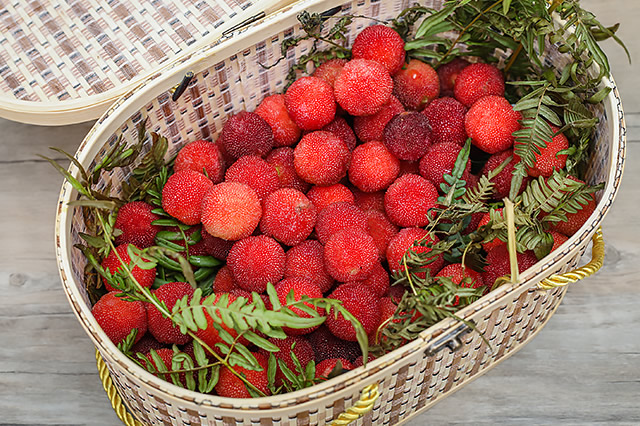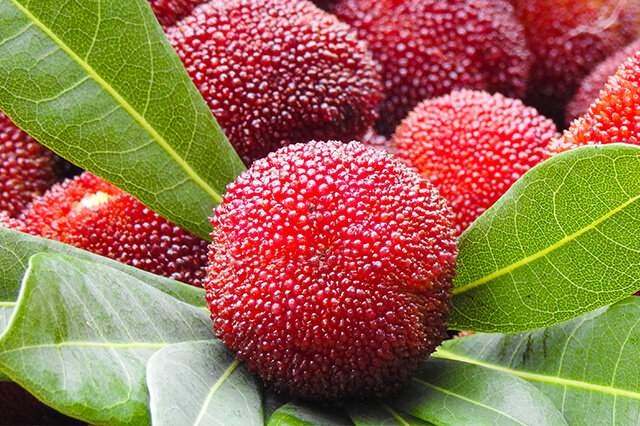bayberry got its name because of its shape and taste like plum. Bayberry is a fruit native to China, and it is cultivated in many regions of China. So where is China rich in bayberry? This post will bring the top ten bayberry producing areas in China.
1. Yuyao Bayberry 余姚杨梅

Yuyao bayberry is a special product of Yuyao City, Zhejiang Province, and a product of China’s National Geographical Indication. In 1995, Yuyao was named “Hometown of Chinese bayberry” by the Central Ministry of Agriculture. The main varieties of bayberry in Yuyao are water chestnut, pink, crystal, lychee, early and late, and more than 20 varieties. Yuyao is located in the southern edge of the subtropical zone and has a monsoon climate with four distinct seasons, abundant sunshine and abundant rainfall. The production area conditions are also conducive to the production and quality improvement of bayberry, and Yuyao belongs to the most suitable climate zone for bayberry, which has given birth to the characteristics of Yuyao bayberry with high yield, large size, bright color, juicy, good fruit quality and low acid content.
2. Jingzhou Bayberry 靖州杨梅

Jingzhou bayberry refers to the bayberry populations distributed in Jingzhou area, including planted bayberry. The place of origin is located in Jingzhou, one of the four main producing areas of bayberry in China. Jingzhou bayberry has a long history of cultivation. It is a special product of Jingzhou County, Huaihua City, Hunan Province, and a national geographical indication of agricultural products. In the Qing Dynasty, Jingzhou bayberry was a pilgrimage tribute. Jingzhou has no sweltering heat in summer and less severe cold in winter, with mild temperature, abundant rainfall and sufficient heat, which is suitable for the cultivation of bayberry. Jingzhou bayberry is bright in color, thick and juicy, with small core, spherical fruit, with radial grooves on the top of the fruit, reaching the middle of the fruit. .
3. Qingtian Bayberry 青田杨梅
Qingtian bayberry is a specialty product of Qingtian County, Lishui City, Zhejiang Province. It is one of the most well-known bayberry varieties on the market and a national geographical indication of agricultural products. bayberry has a long history of cultivation in Qingtian. Qingtian bayberry has traditional varieties such as Xiakeng plum, Kuishi plum, Chashan plum, and black charcoal plum. Among them, Kuishi plum matures early, and Xiakeng plum has the best quality and is well-known. The geographical protection area of Qingtian bayberry geographical indication is in Qingtian County in the south of Zhejiang Province and the middle and lower reaches of the Oujiang River. Qingtian has a mid-subtropical monsoon climate with four distinct seasons, abundant rainfall, warm and humid, which is conducive to the early-maturing and high-quality production of bayberry. Qingtian bayberry fruit is nearly round in shape, with dark red to purple-black surface, tender meat, rich juice, sweet and sour taste, and rich flavor.
4. Fumin Bayberry 富民杨梅
Fumin bayberry is produced in Fumin County, Kunming City, Yunnan Province, and is a product of China’s National Geographical Indication. The bayberry in Fumin County is reasonably matched with early-maturing and late-maturing varieties, so that the picking period is long. The main varieties are water chestnut, Dongkui and some early water chestnut honey, late water chestnut honey and a small amount of late rice plum, white crystal, black golden plum and Dingao. plum. According to the editor’s understanding, Fumin red bayberry fruit has the characteristics of large core and small core, bright color, juicy, moderate sour and sweetness, aroma, early maturity, better storage and transportation, and high nutritional value. Because of its large size, the locals call it “big tree bayberry”.
5. Ding Ao Bayberry 丁岙杨梅
Ding’ao bayberry grows in Ding’ao, which is located in Chashan Town, Ouhai District, Wenzhou City, Zhejiang Province. Ouhai has a subtropical marine climate, with mild and humid all year round, abundant rainfall, sufficient sunshine, short winter and long summer, four distinct seasons, synchronous changes in water and heat, and an annual relative humidity of 80%. Good climate conditions are very suitable for growing bayberry. Ding’ao bayberry is characterized by plump and blunt fruit flesh column, tender and brittle without piercing, bright purple-black color, long fruit stalk, green, with a red spherical protrusion at the base of the fruit stalk, known as “red plate green pedicle”. In 2007, the former General Administration of Quality Supervision, Inspection and Quarantine approved the implementation of geographical indication product protection for “Ding’ao bayberry”.
6. Shiping Bayberry 石屏杨梅
Shiping bayberry is produced in Shiping County, Honghe, Yunnan, and is a national geographical indication of agricultural products. Shiping is one of the main areas where wild bayberry is distributed in my country. It is extremely rich in wild resources. At present, four wild bayberry varieties have been found, including dwarf bayberry, fine bayberry, Itaimei, and Wuxiongmei. Shiping is also one of the first batch of national-level South Asian hot crops of bayberry, a famous, special and rare base county. It is the earliest mature area of Dongkui varieties in China. The selected bayberry varieties are all high-quality products, such as water chestnuts and Dongkui products. Shiping bayberry fruit is medium and large, irregular round or oblate spherical when mature, the fruit surface is bird-purple, the flesh is soft, moderately sweet and sour, the interior is red or light red, the juice is rich, the aroma is small, and the nucleus is small.
7. Huangyan Dongkui Bayberry 黄岩东魁杨梅
The origin of Huangyan Dongkui bayberry is Huangyan District, Taizhou City, Zhejiang Province. Huangyan District is one of the important producing areas of bayberry in Zhejiang Province. According to the editor’s understanding, its name is to take Huangyan Dong’ao bayberry as the head of bayberry, and it is named “Dongkui” and listed as a separate species. Huangyan Dongkui bayberry is a national geographical indication of agricultural products. Huangyan Dongkui bayberry fruit is large and spherical; the color is dark red to purple-black, shiny; the meat column is plump, tender and juicy, sweet and sour, and has a unique flavor.
8. Cixi Bayberry 慈溪杨梅
Cixi bayberry is a special product of Cixi City, Zhejiang Province, and a national geographical indication of agricultural products. Cixi bayberry has a long history. Henghe Town, Cixi City, is the famous hometown of bayberry in my country and the origin of the water chestnut species bayberry. Cixi bayberry production area is located in the foothills of the northern hills of Siming Mountain, with sufficient sunshine and rainfall throughout the year, mild climate and four distinct seasons. The swelling gives Cixi bayberry a unique flavor. Its main cultivar, water chestnuts, is the fruit of mellow, tender flesh, juicy and rich in flavor, sweet and sour, purple-black in color, rich in luster, fragrant, very small in nucleus, and extremely sweet in taste, and has the reputation of “agate in fruit”.
9. Xilu Wusu Bayberry 西胪乌酥杨梅
Xilu Wusu bayberry is a special product of Xilu Town, Chaoyang District, Shantou City, Guangdong Province, and a product of China’s National Geographical Indication. According to the editor of the website, Xilu Town has been planting bayberry more than 600 years ago. The main types are black plum and red plum. Among them, Wusu bayberry is regarded as the “best quality” in bayberry. The color of Xilu Wusu bayberry is deep purple red, bright and uniform; the fruit shape is nearly spherical, the pulp is thick and crisp and firm, the pit is small and crisp, the sweet and sour taste is delicious, the taste is unique, and it is famous for its excellent taste.
10. Zhoushan Late Rice Bayberry 舟山晚稻杨梅
Zhoushan late-rice bayberry belongs to the black plum species. Late-rice bayberry is one of the four famous bayberry varieties in China and is a national geographical indication of agricultural products. Zhoushan late rice bayberry cultivation is mainly distributed in Dinghai District of Zhoushan City, especially the late rice bayberry planted in Gaoxue community of Baiquan Town is the most famous. Zhoushan has a long history of late rice bayberry cultivation. At present, there are still nearly 100 mu of late rice bayberry cultivation trees in the area, one of which is 150 years old. Zhoushan City is located at the midpoint of the coast of China. The landform type is islands and hills. The cultivation of late rice and bayberry in Zhoushan is mainly distributed in the low hills along the mountains and the valleys between the two hills. The soil in this area is relatively deep, the climate is mild and humid, and the precipitation is abundant. Suitable for bayberry growth.